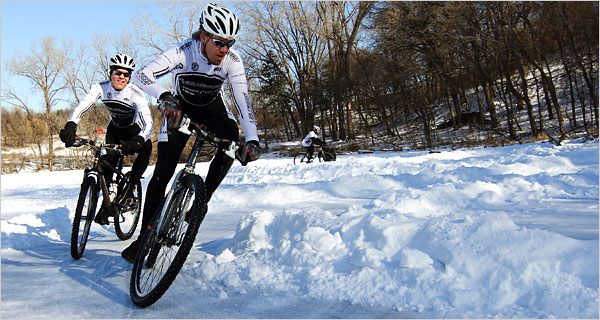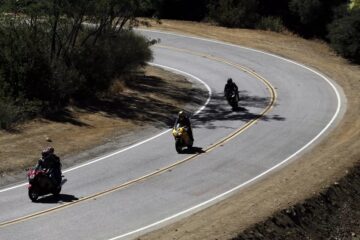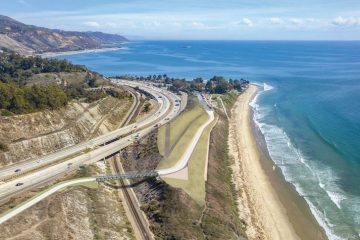Wheels on Ice: Slip-Sliding and Loving It
Source of this article – New York Times, February 2, 2007
By STEPHEN REGENOLD
THE mass perforation of Brownie Lake began at noon, when eight rolling tires, thousands of shiny screw tips and the fast-pumping legs of four bike riders were set in motion on a dizzying figure-eight track of ice.
“Round and round we go,” said Jay Henderson, known as Hollywood, whizzing by on a plane of ice, jockeying for position on a tight turn in the course.

Jay Henderson leads Tim Norrie into a turn on an ice bike racing course in Minneapolis
(photo by T.C. Worley for The New York Times)
Pellets shot off spinning wheels. Four riders cranked and wrangled, a trail of tiny divots left in their wake. The track they rode, a double-loop path on the frozen surface of a lake in Minneapolis, glinted in the afternoon sun.
“Coming on the inside,” Mr. Henderson hollered, squeaking by a rider, his elbows out.
Ice bike racing, a subgenre of the subgenre of winter cycling, is a hybrid discipline where spiked tires bite solid ice on twisting, circuitous courses cut from a mantle of snow. Riders pedal hard on straight-aways, then slide and fishtail through the turns. Frozen lakes and rivers serve as the medium of the sport, which mixes elements of a sprint road race with a dirt bike rally.
Like its cousin sport of ice motorcycling, ice bike racing appeals to a niche of hard-core winter riders, irreverent renegade types and cycling gear aficionados who thrill to toy endlessly with homemade spiked tires.
Organized races started up five or more years ago in places like Minnesota, Alaska, Ontario and Manitoba, some being underground affairs with just a dozen competitors.
Nationally, there is no ice bike racing organization. The clubs that put on events are disparate and not in communication with one another. There are no rules or standards, making every race different.
But an ever-increasing trickle of interest in wintertime riding has helped raise awareness of the events. At competitions like the Chilly Chili Ice Race, held each January on a frozen lake in Bloomington, Minn., more than 100 riders regularly show up.
“It’s a strange crew that does our race,” said Chuck Hood, a director of the Chilly Chili race, which celebrated its five-year anniversary with a race last Sunday. Mr. Hood, a 36-year-old product manager at a bike-parts distribution company, said ice racers tended to be “mountain bikers, urban single-speeders or cabin-feverish roadies blowing off steam.”
Though there are serious racers like Mr. Henderson — a 35-year-old bike shop owner who is a four-time Chilly Chili champion — most ice bikers are casual competitors.
“We get everyone from college students to retirees on the ice,” said Carlos Lozano, the 63-year-old organizer of the Frigid Bits Race Series in Anchorage, where ice bikers pedal a plowed lane on the surface of Goose Lake. From November to March, usually two times per month, Mr. Lozano directs a Frigid Bits race, which is free and open to anyone. Racers make laps on a mile-long labyrinth of a course that this year features 36 snaking turns.
“I prefer to design my race courses after the Formula One venues,” said Mr. Lozano, a retiree who spends hours digging a 12-foot-wide lane with a snowplow-equipped A.T.V.
On race day, mountain bikes are the steed of choice for most ice riders, though cyclocross bikes and simple single-speeds are also used. Commercially made tires with carbide studs from companies like Suomi Tyres, Schwalbe and Kenda populate most of the rims spinning on a course.
The most serious competitors make their own tires, drilling hundreds of holes in the tread, inserting screws, and padding the interior face with duct tape, rubber, silicon caulking and other secret concoctions. Screw size and type varies from racer to racer.
“My tire methods are strictly off the record,” said Mr. Henderson, who incorporates more than 600 screws to create a pair of medieval-looking ice-chewers that can corner at nearly 90 degrees on the glare ice of a hockey rink.
On a Saturday last month, the weekend before the Chilly Chili Ice Race, Mr. Henderson parked on a neighborhood street near downtown Minneapolis and carried his bike through the woods to Brownie Lake. A small group was assembling for a training session at noon.
Skiers glided by on the trails that surround the lake. The ice bikers shoveled snow from their course for 20 minutes before taking off.
Rounding a corner, shoulders leaning into the turn, Kristy LaVigne let out a little squeal. “Oooh, yikes, whee!” she shouted, her tires digging into a sheen of exposed ice.
Ms. LaVigne, a 26-year-old office manager from Circle Pines, Minn., touched the brakes and skidded, her rear tire sliding sideways like fingernails on slate.
“These things more or less seem to work,” said Ms. LaVigne, coming to a stop, looking down at her front wheel. “Really, it feels like you’re on pavement most of the time.”
But the track ahead, a tight 500-foot looped trail, had patches as shiny as glass. A coat of fluffy white covered the nearby forest floor.
The riders formed a line on the straight-aways, spinning fast while sitting down, then coming together in a crush at each corner. They rode lap after lap, tires aerating the ice.
“Look out, coming through,” yelled Tim Norrie, a 31-year-old electrician from Minneapolis, brushing by a rider on a turn.
Crashes on ice are common, and during the Brownie Lake session riders went down a dozen times, tipping after taking a corner too fast, or flying over handlebars while ramming a snow bank. The sparring sessions during tight turns — shoulders nudging, elbows poking out — didn’t help either. (Though such moves are much more subtle in a real race.)
Ms. LaVigne, a former hockey player and first-time ice biker, was cautious of her knees. “I know how hard ice can be in a bad fall,” she said, stopping to let three riders whiz by.
Russell Loucks, a 45-year-old software engineer from Eagan, Minn., put a foot down to skim the ice on fast turns, his shoe skating as a solid outrigger for balance.
Across the ice, on a packed trail that circles the lake, a skier stopped to assess the scene, hand blocking the sun in a salute on his forehead. A dog ran free nearby, dragging a leash through the snow.
On a turn in the course, Mr. Norrie scooted in for a shoulder check, and Mr. Henderson went flying, bouncing on the ice. But Mr. Henderson stood up smiling and brushed himself off. “I’ll be feeling that one tomorrow,” he said.
By 1 p.m., the winter sun cast long shadows on the track. Ms. LaVigne rode up front, confident on the bike after only an hour of practice. Her feet spun on the pedals. Her tires hummed on the ice.
VISITOR INFORMATION
STUDDED bike tires meet the ice at events throughout North America each winter, including skating-rink sprints in Toronto, river ice races in Winnipeg and ice-biking events twice a month in Anchorage. Here’s a schedule of coming races:
MONTREAL The Coupe des Glaces 2007 will be held tomorrow at Bonsecours skating rink, where racers sprint laps in multiple elimination heats. Now in its fourth year, the Coupe des Glaces attracts more than 50 ice bikers (www.coupedesglaces.org).
WINNIPEG, MANITOBA Winnipeg’s Icebike 9, its ninth annual ice biking event, is scheduled for Sunday at the Forks National Historic Site near downtown. Up to 200 competitors pedal a course that travels on river ice and into the woods (www.icebiking.com).
ANCHORAGE The Frigid Bits Race Series in Anchorage has races on Feb. 10 and Feb. 24 at Goose Lake. Competitors pedal a labyrinthine mile-long course that has 36 turns. Races start at 7 p.m., and there is no entry fee. Contact the race organizer, Carlos Lozano, by e-mail for more information: rio@ak.net.
TORONTO Two ice-skating rinks at Dufferin Grove Park are the site for the Feb. 24 Icycle Race. About 40 racers compete each year in a series of rounds that can include up to 60 laps in a row. Information: (416) 532-6392.




0 Comments